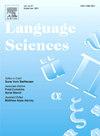语言联觉与体现:基于普通话情态排他性规范的研究
IF 1.1
2区 文学
Q2 EDUCATION & EDUCATIONAL RESEARCH
引用次数: 0
摘要
本研究旨在通过提出一个经验模型:感知强度的体现(PSE)来解决目前关于语言联觉中感觉模态体现的争论。感官形容词的体现感强度是根据五个感官模态中形容词的感官评分来测量的,而每个感官模态的体现感强度是根据所有形容词根据其主导模态的PSE来计算的。PSE旨在解决被广泛接受的基于模态的体现不对称中的一个突出困境:即这种不对称无法预测感官词之间的方向性行为,因为每个感官词通常与多个模态相关联,并且每个模态可能具有不同的关联强度。通过对感官形容词的分析,我们发现基于词汇概念的体现不对称比基于情态的体现不对称更能解释数据,此外,基于词汇概念的解释也得到了汉语联觉复合形容词数据的支持。总之,本文认为PSE模型是一种测量体现程度的实证方法,进一步理解体现在感官知觉的语言概念化中的作用。本文章由计算机程序翻译,如有差异,请以英文原文为准。
Linguistic synesthesia and embodiment: A study based on Mandarin modality exclusivity norms
This study aims to resolve the ongoing debate about sensory modality embodiment found in linguistic synesthesia by proposing an empirical model: Perceived Strength of Embodiment (PSE). The perceived strength of embodiment for sensory adjectives is measured based on the sensory ratings of the adjectives in the five sensory modalities, while the perceived strength of embodiment for each sensory modality is calculated based on the PSE of all adjectives according to their dominant modalities. PSE is designed to address a salient dilemma in the widely-accepted modality-based embodiment asymmetry: that is, such asymmetry fails to predict the directionality behaviors between sensory words because each sensory word is typically associated with more than one modality, and each may have different strengths of association. Based on an analysis of sensory adjectives, we find that a lexical concept-based embodiment asymmetry better explains the data than a modality-based embodiment asymmetry and, additionally, the lexical concept-based account is supported by Mandarin synesthetic compound adjective data. In sum, this paper argues that the PSE model is an empirical approach to measuring the degree of embodiment which furthers the understanding of the role of embodiment in the linguistic conceptualization of sensory perceptions.
求助全文
通过发布文献求助,成功后即可免费获取论文全文。
去求助
来源期刊

Language Sciences
Multiple-
CiteScore
2.90
自引率
0.00%
发文量
38
期刊介绍:
Language Sciences is a forum for debate, conducted so as to be of interest to the widest possible audience, on conceptual and theoretical issues in the various branches of general linguistics. The journal is also concerned with bringing to linguists attention current thinking about language within disciplines other than linguistics itself; relevant contributions from anthropologists, philosophers, psychologists and sociologists, among others, will be warmly received. In addition, the Editor is particularly keen to encourage the submission of essays on topics in the history and philosophy of language studies, and review articles discussing the import of significant recent works on language and linguistics.
 求助内容:
求助内容: 应助结果提醒方式:
应助结果提醒方式:


